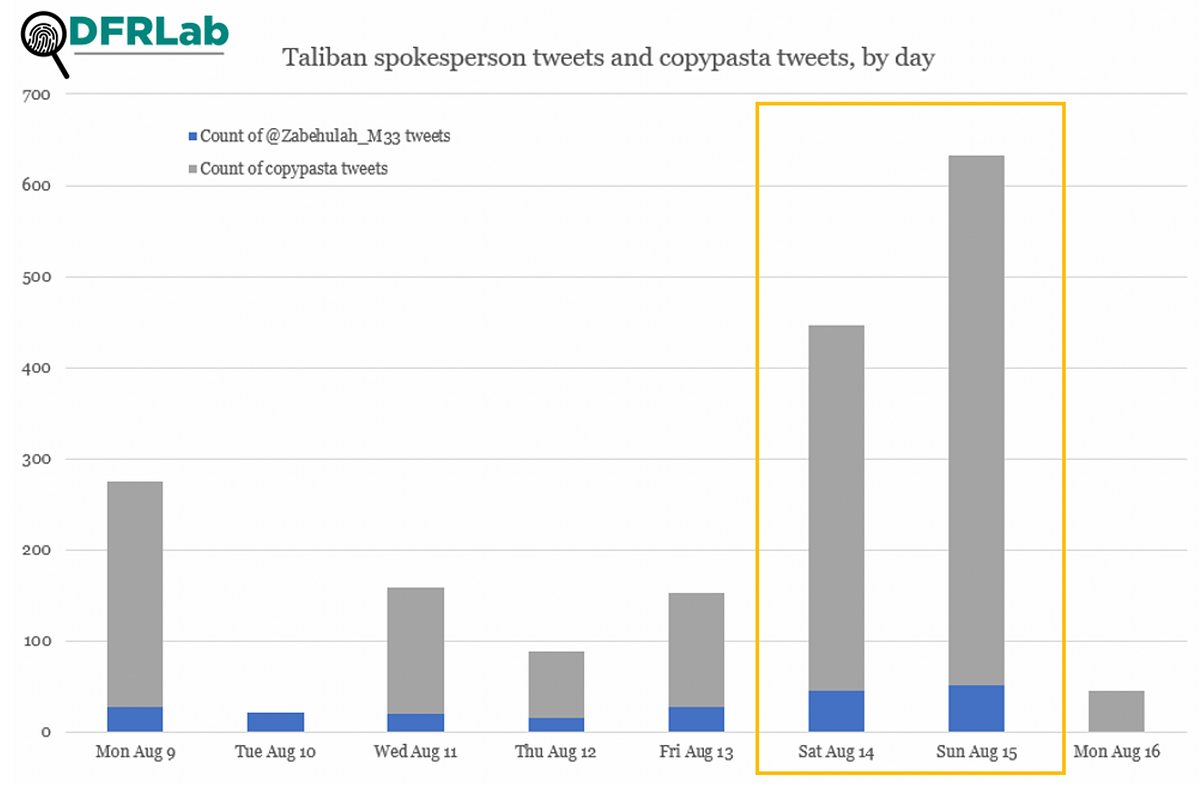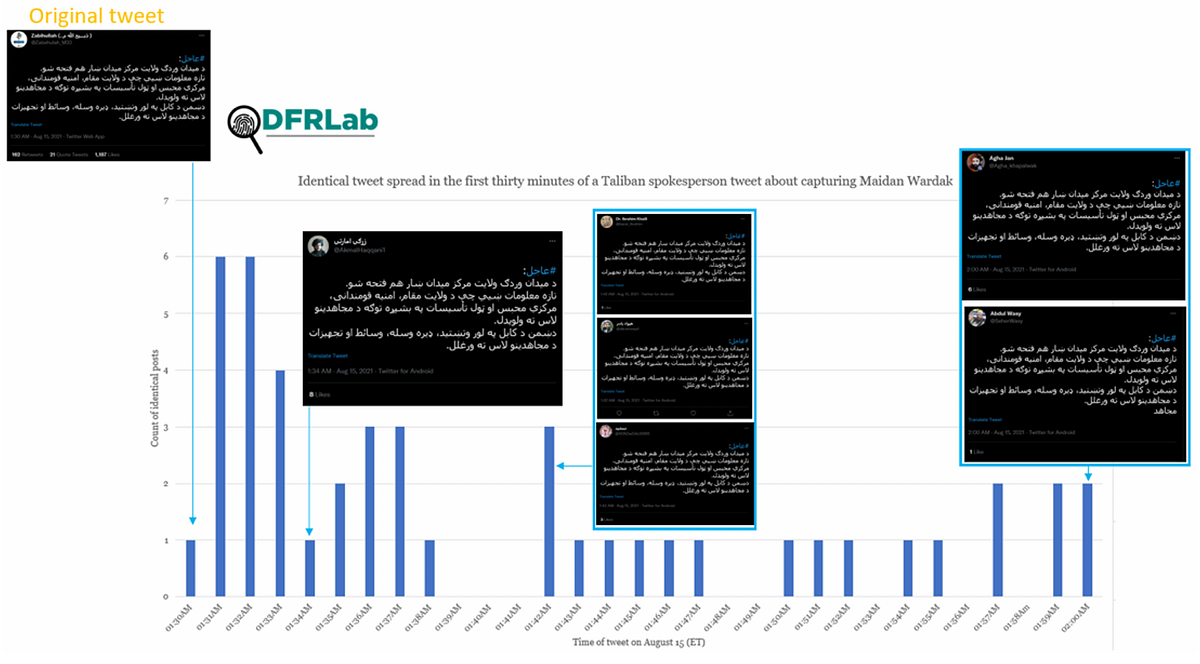Accounts flooded Twitter with copy-pasted messages from the Taliban’s spokesperson as the insurgency overtook Kabul

By Alyssa Kann
The most followed Taliban spokesperson bombarded Twitter with triumphant propaganda as the Taliban captured more than a dozen of Afghanistan’s provincial capitals in a week, culminating in the fall of the Kabul.
A majority of tweets by Taliban spokesperson Zabiullah Mujahid (@Zabehulah_M33) received engagement not only through likes and retweets, but also through more than 1,600 copied messages tweeted out by other user accounts. This engagement via “copypasta” (slang for copy-and-pasted identical text) reached its zenith as the Taliban took control of Kabul on August 15. The tweets amplified most by this method regarded victories of great strategic or symbolic importance to the Taliban. Later, this extended to messages emphasizing calm and moderation as the Taliban moved to occupy Afghanistan’s capital city.
The Taliban has sought to consolidate, control, and amplify its propaganda on social media as it gained control of Afghanistan — federating around specific spokespeople, controlling a message focused on the Taliban’s inevitability while not highlighting extremists or extremism within its ranks, and amplifying via copypasta to create redundancy as some Taliban accounts are removed from platforms.
The Taliban’s Twitter tactics have been shown to shift rapidly based on events on the ground. Taliban-associated accounts, some with bot-like indicators, previously pushed a hashtag and reposted identical messages highlighting electoral violence directly ahead of the 2019 Afghan election. The rapid Taliban offensive, which defeated an Afghan government supported by 20 years of US and allied military intervention, refined this propaganda strategy via social media further.
While there have been reports of ethnic violence, reprisal killings, and other human rights abuses by the Taliban, the group’s more centralized propaganda on social media have sought both to present a different message to the international community and to remain on platforms.
The Taliban’s lead spokesperson on Twitter
The English and Dari versions of the Taliban’s website feature the Twitter feeds of three of its spokespeople on their front page. The most followed of these spokespeople is @Zabehulah_M33, who has over 329,000 followers on the platform. While @Zabehulah_M33 tweets an average of 21 times a day, according to a Twitonomy query covering March 2021 through August 2021, he tweeted well above that average nearly every day in the month of August. From Thursday, August 12, through Sunday, August 15, as the Taliban gained territorial control of Afghanistan, the frequency of @Zabehulah_M33’s messages increased.

Tweets and copypasta
In a tactic evoking how Taliban-associated accounts previously reposted @Zabehulah_M33 messages to Twitter, the DFRLab found that 74 percent of @Zabehulah_M33’s tweets over the past week were reposted verbatim in unique tweets by other Twitter accounts. These copypasta tweets extended @Zabehulah_M33’s original tweets beyond the typical Twitter amplification framework of likes and retweets.

The copypasta tweets reached their second highest and highest volumes, respectively, on Saturday, August 14, and Sunday, August 15, the day Kabul was taken by the Taliban. On those days, 97 official spokesperson tweets became 983 additional tweets from various Taliban-supporting accounts.
This copypasta amplification pattern appears to have been at least partially artificial, and the timing of many copied tweets was often within a minute or two of a @Zabehulah_M33 tweet. The Taliban are well-versed in evading platform takedowns and purposefully build redundancies in their social media and web presence, so that even when some accounts are banned, others still exist to promote the message. Many of the copied tweets also used hashtags; the rapid amplification of tweets in reposts could be a way to manipulate Twitter’s trending algorithms and artificially boost Taliban content quickly.
Broadcasting victories important to the insurgency
The Taliban focused this artificial amplification on targets of particular strategic or symbolic importance to the insurgency. As the Taliban reached targets like Mazar-i-sharif and cities close to Kabul, the Twitter amplification of their announcements served to intimidate and posture, demonstrating the Taliban’s growing strength. Many of these tweets, written in a formulaic manner in Pashto, specifically referenced governors’ quarters, police headquarters, and prisons in various locations that had just been captured, stating that weapons and equipment were taken by the Taliban.

For example, prior to the fall of Mazar-i-Sharif, a city in Afghanistan’s north that holds strategic value because of its size and location and symbolic value due to the historical resistance to the Taliban by the Northern Alliance, the Taliban posted four messages that were reposted in at least 134 separate tweets. All four messages seemed designed to intimidate: they provided updates that the Taliban were “advancing rapidly” on the city, continuing to fight, and launching operations “from all four sides of the city.” The tweets were originally posted by @Zabehulah_M33 on August 9 and August 14; the city was captured later in the evening of August 14 and was the last large northern city to fall to the Taliban.
As the Taliban offensive gathered momentum, so did its Twitter propaganda campaign. Another three tweets that garnered significant copypasta concerned the Taliban fighting and conquering cities close to Kabul (see red arrows on graph above). On Friday, August 13, @Zabehulah_M33 tweeted that “the enemy forces were severely defeated” in the southern part of Pul-e-alam, a city 70 kilometers from Kabul. This message garnered 23 other copypasta tweets. A later Friday message, copied in 20 other tweets, relayed that the governor of Pul-e-alam and all of his personnel had surrendered to the Taliban, but that fighting in other areas was ongoing.
As the Taliban seized cities closer to Kabul, concern within the city mounted. A Sunday, August 15, Taliban message announced that Maidan Wardak — a city 50 kilometers from Kabul — had been captured. This tweet was quickly amplified by other users: in the 30 minutes after it was first posted by @Zabehulah_M33, its text was reposted in separate tweets an additional 46 times, many in the same minute. In total, 58 different user accounts tweeted out 58 identical Maidan Wardak messages, all on Sunday, August 15, in a period of less than four hours.

Two of the most copied @Zabehulah_M33 tweets occurred after the fall of Kabul (see orange arrows on graph above). The two tweets, reposted in at least 109 other tweets, stated that everyone in Kabul, including foreigners and diplomatic mission personnel, were safe and that the Taliban would maintain peace. These messages were likely intended to reduce the panic in Kabul and to present a moderate face to international observers.

Conclusion
As the Taliban regains control of Afghanistan in a world much changed from the last time it held power, it has sought to consolidate its messengers, present a rosier image, amplify coordinated propaganda on social media, and control information about extremism or human rights abuses.
In the last week, the Taliban’s lead spokesperson was increasingly active on Twitter as the Taliban gained control of Afghanistan, peaking on August 15, with the fall of Kabul. Most of the spokesperson’s tweets were also copied in identical messages by other Twitter user accounts; these copypasta messages also peaked on August 15. This amplification mechanism served to further emphasize strategically important moments in the Taliban’s rapid insurgency, working to intimidate and threaten and to relay moment-to-moment announcements.
Alyssa Kann is a Research Assistant with the Digital Forensic Research Lab.
Special thanks to Ayman Aziz, Pashto linguist and Af-Pak regional analyst, for his translation assistance.
Cite this case study:
Alyssa Kann, “As the Taliban offensive gained momentum, so did its Twitter propaganda campaign,” Digital Forensic Research Lab (DFRLab), August 19, 2021, https://medium.com/dfrlab/as-the-taliban-offensive-gained-momentum-so-did-its-twitter-propaganda-campaign-75021ba3082.
Follow along for more in-depth analysis from our #DigitalSherlocks.

